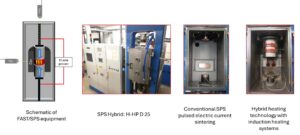This website uses cookies so that we can provide you with the best user experience possible. Cookie information is stored in your browser and performs functions such as recognising you when you return to our website and helping our team to understand which sections of the website you find most interesting and useful. More information in our Privacy Policy
Hybrid Spark Plasma Sintering (SPS) Furnace
FCT System: Hybrid SPS H-HP D25
Supervisors: Failla Simone, Sangiorgi Alex
Spark Plasma Sintering (SPS) is an innovative sintering technology that uses high-intensity direct current pulses to generate rapid and localized heating directly within the material. This mechanism significantly reduces processing times and enables the production of dense materials with controlled microstructures, minimizing grain growth.
The ISSMC-CNR Institute has an advanced SPS sintering system with hybrid heating technology, integrating pulsed electric current sintering (FAST/SPS) with induction heating systems. This combination compensates for the typical thermal gradients of the standard process, optimizing temperature homogeneity and improving heating rates.
Thanks to hybrid technology, the system is particularly suitable for sintering materials with low thermal conductivity and large-format components, ensuring precise microstructure control and limiting grain growth in nanomaterials.

Materials and Applications
The furnace allows the processing of a wide range of materials, including:
- Nanomaterials with reduced grain growth
- Ultra High Temperature Ceramics (UHTC) such as ZrB₂, HfB₂, TaB₂, HfC, WC, TaC…
- Functionally Graded Materials (FGM)
- Composite materials and innovative carbides
- Aluminum, copper alloys, and intermetallic compounds
- Structural and functional ceramics
Technical Features
- Maximum applicable pressure: 250 kN
- Maximum temperature: 2500 °C (1400 °C in air)
- Heating power:
- FAST/SPS: 60 kW
- Induction: 80 kW
- Hybrid technology: 100 kW
- Heating rates up to 1000 K/min (depending on tool size and material)
- Advanced temperature control via axial/radial pyrometers and flexible thermocouples
- Programmable sintering parameters with up to 100 segments per recipe
- Possibility of operating in controlled atmospheres (Ar, N₂, He, Vacuum)
- Rapid cooling systems
Advantages of Hybrid Technology
The integration of pulsed electric current heating and induction heating allows:
✔ Better thermal homogeneity, reducing radial temperature gradients
✔ Higher energy efficiency and faster processing
✔ Optimal densification control and improved material quality
✔ Versatility in processing advanced materials
This cutting-edge technology places ISSMC-CNR among the most advanced research centers in the sintering of innovative materials, offering new opportunities for developing high-performance components for industrial and scientific applications.

